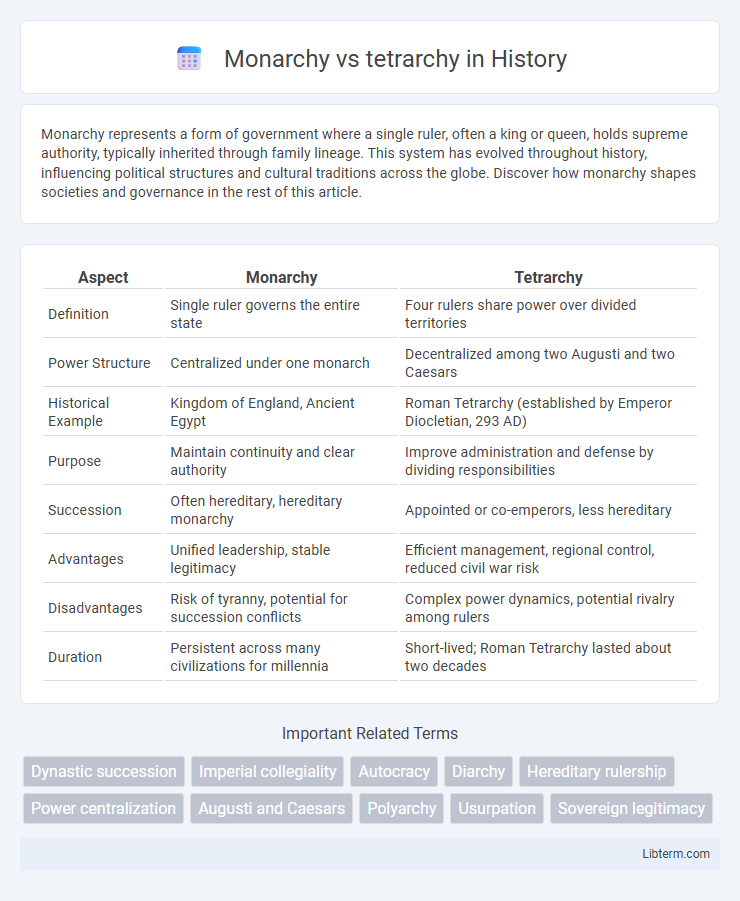Monarchy represents a form of government where a single ruler, often a king or queen, holds supreme authority, typically inherited through family lineage. This system has evolved throughout history, influencing political structures and cultural traditions across the globe. Discover how monarchy shapes societies and governance in the rest of this article.
Table of Comparison
| Aspect | Monarchy | Tetrarchy |
|---|---|---|
| Definition | Single ruler governs the entire state | Four rulers share power over divided territories |
| Power Structure | Centralized under one monarch | Decentralized among two Augusti and two Caesars |
| Historical Example | Kingdom of England, Ancient Egypt | Roman Tetrarchy (established by Emperor Diocletian, 293 AD) |
| Purpose | Maintain continuity and clear authority | Improve administration and defense by dividing responsibilities |
| Succession | Often hereditary, hereditary monarchy | Appointed or co-emperors, less hereditary |
| Advantages | Unified leadership, stable legitimacy | Efficient management, regional control, reduced civil war risk |
| Disadvantages | Risk of tyranny, potential for succession conflicts | Complex power dynamics, potential rivalry among rulers |
| Duration | Persistent across many civilizations for millennia | Short-lived; Roman Tetrarchy lasted about two decades |
Introduction to Monarchy and Tetrarchy
Monarchy centers on a single sovereign ruler who holds supreme authority, often inherited through dynastic succession. Tetrarchy divides power among four rulers, typically established to manage large empires more effectively by sharing administrative and military responsibilities. This system was notably implemented in the late Roman Empire to address challenges of governance and defense across extensive territories.
Historical Origins of Monarchy
The historical origins of monarchy trace back to ancient civilizations where centralized authority was vested in a single ruler, often justified by divine right or hereditary succession. Monarchies emerged as stable forms of governance by consolidating power to maintain order, collect taxes, and lead militaries, evident in early examples such as Mesopotamia, Ancient Egypt, and the early Kingdom of Israel. In contrast, the tetrarchy, established by Roman Emperor Diocletian in the late 3rd century AD, divided imperial power among four rulers to address administrative challenges and military pressures.
Historical Development of Tetrarchy
The tetrarchy emerged in the late Roman Empire under Emperor Diocletian in AD 293 as a strategic system to address empire-wide administrative and military challenges by dividing power among two senior emperors (Augusti) and two junior emperors (Caesares). This governance model aimed to stabilize succession and enhance regional control, contrasting with the traditional singular rule of monarchy that often led to power struggles. Despite its initial successes in promoting order, the tetrarchy eventually dissolved due to internal conflicts and failed to establish a long-lasting political structure.
Structural Differences: Monarchy vs Tetrarchy
Monarchy features a single ruler wielding centralized authority, while tetrarchy divides power among four co-emperors governing distinct regions. The structural design of monarchy centralizes decision-making and maintains continuity through hereditary succession, contrasting with the tetrarchy's systematic distribution of administrative responsibilities to enhance regional control and stability. This division in tetrarchy limits autocratic rule and seeks to prevent internal power struggles typical of monarchical systems.
Power Distribution: Centralization vs Decentralization
Monarchy centralizes power in a single ruler, concentrating authority and decision-making within one individual, often leading to a unified governance structure. In contrast, tetrarchy divides power among four rulers, promoting decentralization by distributing control across multiple leaders to manage different regions or functions. This system aims to balance authority and improve administrative efficiency through shared governance.
Succession and Stability in Both Systems
Monarchy often relies on hereditary succession, which can lead to clear lines of inheritance but also risks instability through disputes or weak heirs, impacting long-term governance. Tetrarchy divides power among multiple rulers, aiming to prevent succession crises by creating a structured system for appointing successors, enhancing stability through shared authority. However, the tetrarchic model may face challenges from conflicting ambitions among co-rulers, occasionally undermining centralized control despite its designed stability.
Advantages of Monarchy
Monarchy offers centralized authority that ensures swift decision-making and consistent governance, often leading to political stability and unified national identity. The clear line of succession in monarchies can reduce power struggles and provide continuity in leadership. Monarchs often act as symbolic figures which can strengthen cultural cohesion and national pride.
Benefits and Drawbacks of Tetrarchy
Tetrarchy divided power among four rulers, reducing the risk of absolute tyranny and improving administrative efficiency across vast territories like the Roman Empire. It allowed for quicker military responses and localized governance but created potential for internal conflict and power struggles between co-emperors. Unlike monarchy's centralized authority, tetrarchy's distributed leadership often led to instability and fragmentation.
Notable Examples in History
The Roman Empire exemplified tetrarchy under Emperor Diocletian, who established a system dividing power among two senior emperors (Augusti) and two junior emperors (Caesars) to enhance administrative efficiency and security. In contrast, the British monarchy stands as a prominent example of a longstanding hereditary monarchy, with a single sovereign ruling over the United Kingdom and its territories. The Ottoman Empire's absolute monarchy under sultans like Suleiman the Magnificent also highlights centralized monarchical power, contrasting with the shared authority structure of tetrarchy.
Conclusion: Modern Relevance and Lessons
The monarchy system, characterized by centralized royal authority, contrasts with the tetrarchy's division of power among multiple rulers, offering insights into governance adaptability and stability. Modern governments can learn from the tetrarchy's attempt to prevent power concentration and enhance administrative efficiency through power-sharing, while monarchies demonstrate the risks of autocratic rule. These historical models emphasize the importance of balancing authority and collaboration to address complex political challenges in contemporary governance structures.
Monarchy Infographic

 libterm.com
libterm.com